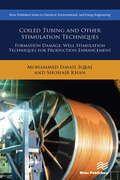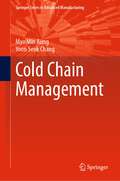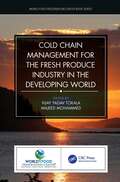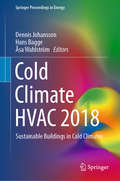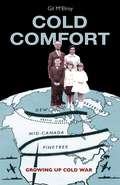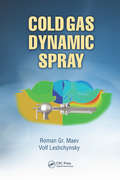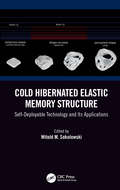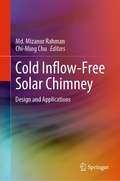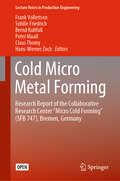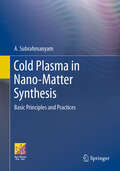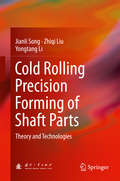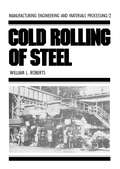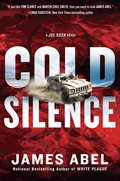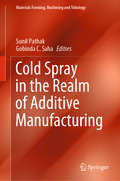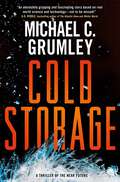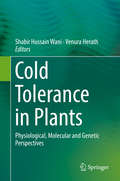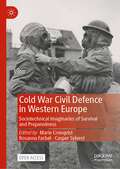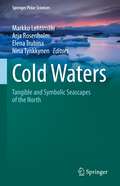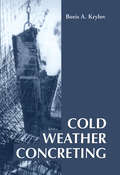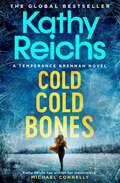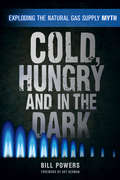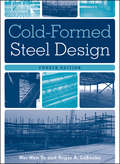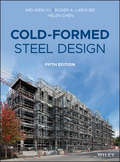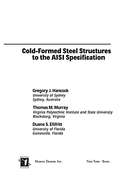- Table View
- List View
Coiled Tubing and Other Stimulation Techniques: Formation Damage, Well Stimulation Techniques for Production Enhancement (River Publishers Series In Chemical, Environmental, And Energy Engineering Ser.)
by Mohammed Ismail IqbalGood engineers never stop looking for opportunities to improve the performance of their production systems. Performance enhancement methods are always carefully examined, and production data is analyzed in order to identify determining factors affecting performance.The two main activities of the production engineer in the petroleum and related industries are reservoir stimulation and artificial lift. The classic solution to maximizing a well's productivity is to stimulate it. The basis for selecting stimulation candidates should be a review of the well's actual and theoretical IPR. Low permeability wells often need fracturing on initial completion. In low permeability zones, additional post stimulation production can be significant to the economics, however, the production engineer needs to make management aware of the true long term potential or else overly optimistic projections can easily be made.The main purpose of stimulation is to enhance the property value by the faster delivery of the petroleum fluid and/or to increase ultimate economic recovery. The aim of reservoir stimulation is to bypass near-wellbore damage and return a well to its “natural” productivity / injectivity, to extend a conductive path deep into a formation and thus increase productivity beyond the natural level and to produce hydrocarbon from tight formation.The importance of reservoir stimulation is increasing due to following reasons: • Hydrocarbon fields in their mid-life• Production in these fields are in declining trend• The thrust area: Enhancement of productionHence, to improve productivity of the well matrix stimulation and hydraulic fracturing are intended to remedy, or even improve, the natural connection of the wellbore with the reservoir, which could delay the need for artificial lift.This book presents procedures taken in the Oil & Gas Industry for identifying well problems, and it suggests means of solving problems with the help of the Coil Tube unit which is used for improving well productivity and techniques like Acidizing and Hydraulic Fracturing.
Cold Chain Management (Springer Series in Advanced Manufacturing)
by Myo Min Aung Yoon Seok ChangThis text helps readers to build a solid understanding of the key concepts in the management and operation of supply chains involving chilling, refrigeration or freezing. Emphasis is placed on environmental—particularly temperature—control as important in avoiding irreversible damage to product quality and safety and the resulting loss of profit and consumer confidence. The authors explain the important issues arising within the supply chain of perishable goods from production to consumption: topics that include planning and design, instrumentation and methods of implementation, and process monitoring and control.Reminding the student that cold supply chains are essential for the supply of products more various than foods, product-specific studies and examples are included for handling bananas and vaccines. The importance of product traceability and automation are highlighted.Cold Chain Management is a self-contained guide for graduate and final-year undergraduate students specializing in the study of supply chains, and their instructors. Researchers interested in logistics will find this book instructive when they wish to consider the particular problems associated with cold chains and anyone looking to begin a business in which refrigeration or freezing will be necessary will be well-served by reading this text.
Cold Chain Management for the Fresh Produce Industry in the Developing World (World Food Preservation Center Book Series)
by Vijay Yadav TokalaGlobal food losses are a result of a lack of necessary infrastructure, improper food safety handling procedures, and insufficient training for the personnel working in the cold chain. The development of a resource-efficient and energy-smart food supply chain requires a well-integrated evaluation and development of the cold chain. Cold Chain Management for the Fresh Produce Industry in the Developing World provides a comprehensive review of the benefits of an unbroken cold chain in developing countries and focuses on the critical role of extension education in the implementation of cold chain management. The unbroken cold chain is essential for all stakeholders in the fresh produce industry to maintain the quality and safety of food products during handling, transporting, and storing in their journey from producer to consumer. Appropriate cold chain management is crucial not only to reduce the postharvest losses and wastages, but also to increase farmers' income, generate employment opportunities, and improve the livelihood of stakeholders along the supply chain. Key Features: Includes case studies for promoting the expansion of existing technologies for cold chain development in Asian, Africa and the Caribbean nations. Assesses cold chain management as crucial to the growth of global trade in perishable products with contributions from international organizations, researchers and commercial experts. Articulates resilient, sustainable and creative concepts to develop cold chains to enhance food distribution. This book comprises of chapters contributed by the experts and practitioners of cold chain development in developing countries. The authors in the book provide the scenario of cold chain management in the world and discuss the importance of the cold chain as well as the different options and innovations of cooling systems. Chapters also include case studies, success stories, capacity building activities, and other opportunities in cold chain development.
Cold Climate HVAC 2018: Sustainable Buildings in Cold Climates (Springer Proceedings in Energy)
by Dennis Johansson Hans Bagge Åsa WahlströmThis volume presents the proceedings of the 9th Cold Climate HVAC conference, which was held in Kiruna, Sweden in 2018. The conference highlighted key technologies and processes that allow scientists, designers, engineers, manufacturers and other decision makers in cold climate regions to achieve good indoor environmental quality (IEQ) with a minimum use of energy and other resources. The conference addressed various technical, economic and social aspects of buildings and HVAC systems in new and renovated buildings. This proceedings volume gathers peer-reviewed papers by a diverse and international range of authors and showcases perspectives and practices in cold climate building design from around the globe. The following major aspects, which include both fundamental and theoretical research as well as applications and case studies, are covered: (1) Energy and power efficiency and low-energy buildings; (2) Renovating buildings; (3) Efficient HVAC components; (4) Heat pumps and geothermal systems; (5) Municipal and city energy systems; (6) Construction management; (7) Buildings in operation; (8) Building simulation; (9) Reference data; (10) Transdisciplinary connections and social aspects; (11) Indoor environments and health; (12) Moisture safety and water damage; (13) Codes, regulations, standards and policies; and (14) Other aspects of buildings in cold climates.
Cold Comfort
by Gil McelroyWhen his father died, award-winning poet and curator Gil McElroy was given a box of photographs that documented his father's military career. Beginning in the Second World War and continuing right through to the end of the Cold War, the senior McElroy staffed Canada's network of electronic defence, including the Distant Early Warning Line - a network of radar stations stretching along the Arctic coast from Alaska to Baffin Island. Established in the early 1950s, the DEW Line provided advance warning of an aircraft or missile attack. There, servicemen lived in isolated radar stations, watching surveillance screens for the telltale blips that threatened nuclear annihilation.McElroy reflects on the sacrifices these men made, living away from their families for great lengths of time - for the "greater good" of protecting North American airspace and Western values.At the same time, Cold Comfort follows McElroy's experience of growing up as an itinerant military brat, who moved from one posting to another, and the military family's attempts to hold together in the face of the father's absence. Cold Comfort also explores the utter enigma that was the author's father. Examining the contents of the box of photographs, image by image, McElroy attempts to come to terms with the mysterious photographer, a man better understood by his military compatriots than by his own family.Further, Cold Comfort provides the backstory to McElroy's most recent collection of poems, Ordinary Time, which offers an unsettling history of the utter failures of these remote surveillance technologies to make "our" world either better known or reliably predictable.
Cold Gas Dynamic Spray
by Roman Gr. Maev Volf LeshchynskyYour Guide to Advanced Cold Spray TechnologyCold Gas Dynamic Spray centers on cold gas dynamic spray (or cold spray-CS) technology, one of the most versatile thermal spray coating methods in materials engineering, and effectively describes and analyzes the main trends and developments behind the spray (coating) techniques. The book combines theory
Cold Hibernated Elastic Memory Structure: Self-Deployable Technology and Its Applications (Polymeric Foams)
by Witold M. SokolowskiCold hibernated elastic memory (CHEM) is an innovative, smart material technology that uses shape memory polymers in open cellular structures. This book extensively describes CHEM self-deployable structures, provides basic property data and characteristics, discusses advantages, and identifies numerous space, commercial, and medical applications. Some of these applications have been experimentally and analytically investigated with inspiring results and are revealed here. CHEM technology has a potential to provide groundbreaking self-deployable space structures. Some cutting-edge space CHEM concepts described in this book represent the introduction of a new generation of space deployable structures. CHEM materials have unique characteristics that enable the manufacture of self-deployable stents and other medical devices not possible currently. One of the medical applications, the CHEM endovascular treatment of aneurysm, is being experimentally explored with promising results that would save lives. This book provides a long list of interesting potential commercial CHEM applications that could simplify and make life easier at low cost. One of these products, the self-reconfiguring armchair, is already being set up for mass production. This book will be of interest to all engineering researchers, scientists, engineers, students, designers, and technologists across their relevant fields of interest. The exceptional characteristics of CHEM technology are presently enabling technologists to develop many applications ranging from outer space to inside the human body. As a result, CHEM structures are in the process of reshaping our thinking, approaches, and design methods in many ways that conventional materials and approaches do not allow.
Cold Inflow-Free Solar Chimney: Design and Applications
by Md. Mizanur Rahman Chi-Ming ChuThis book highlights the design of a new type of solar chimney that has lower height and bigger diameter, and discusses its applications. The bigger diameter chimneys are introduced showing cold inflow phenomena that significantly reduced the performance of solar chimney. The cold inflow-free operation of solar chimneys restores the draft losses and enhances the performance of the solar chimneys. Numerical and experimental investigation results will be presented to highlight the performance of cold inflow-free solar chimney performance. In addition, this book covers the important basic design parameters that affect the design of solar chimney for different applications, mainly, solar chimney-assisted ventilation for passive cooling and power generation system.
Cold Micro Metal Forming: Research Report of the Collaborative Research Center “Micro Cold Forming” (SFB 747), Bremen, Germany (Lecture Notes in Production Engineering)
by Peter Maaß Frank Vollertsen Hans-Werner Zoch Sybille Friedrich Bernd Kuhfuß Claus ThomyThis open access book contains the research report of the Collaborative Research Center “Micro Cold Forming” (SFB 747) of the University of Bremen, Germany. The topical research focus lies on new methods and processes for a mastered mass production of micro parts which are smaller than 1mm (by forming in batch size higher than one million). The target audience primarily comprises research experts and practitioners in production engineering, but the book may also be of interest to graduate students alike.
Cold Plasma in Nano-Matter Synthesis: Basic Principles and Practices
by A. SubrahmanyamThis book describes the basic principles and techniques of cold plasma to synthesize nanomaterials, emphasizing the fundamentals. Nanotechnology has matured enough to make inroads into the industry. “Quantum size effects” is the basis of the exotic properties of nanomaterials. The shapes and the size distribution dictate the properties of the nano-matter. The demands of the synthesis technique are to produce nano-matter with uniform size, repeatable shapes, uniform size distribution, stability of the nanostructures (reaching thermodynamic equilibrium), reproducibility of the particle sizes, and reliability of the process. These demands can be met when the synthesis technique has precise control over the process parameters. Cold plasma techniques possess all the requirements of the needs of nanomaterial synthesis. The cold plasma, an evolving field, has been established to be the most powerful tool not only for micro-electronics (both in the deposition and etching) but in many areas like health care, medicine, agriculture, food processing, etc. The book’s primary emphasis is to explain the basic principles and concepts of cold plasma in nanomaterial synthesis. The target audience is undergraduate and graduate students learning nanomaterial synthesis and plasma technology. It is hoped that this book also is a good source of reference for practicing scientists and engineers involved in synthesizing nanomaterials and nanostructures in the industry.
Cold Rolling Precision Forming of Shaft Parts: Theory and Technologies
by Jianli Song Zhiqi Liu Yongtang LiThis book presents in detail the theory, processes and equipment involved in cold rolling precision forming technologies, focusing on spline and thread shaft parts. The main topics discussed include the status quo of research on these technologies; the design and calculation of process parameters; the numerical simulation of cold rolling forming processes; and the equipment used. The mechanism of cold rolling forming is extremely complex, and research on the processes, theory and mechanical analysis of spline cold rolling forming has remained very limited to date. In practice, the forming processes and production methods used are mainly chosen on the basis of individual experience. As such, there is a marked lack of both systematic, theory-based guidelines, and of specialized books covering theoretical analysis, numerical simulation, experiments and equipment used in spline cold rolling forming processes. Illustrated using tables, 3D photographs and formula derivations, this book fills that gap in the literature.
Cold Rolling of Steel
by RobertsWith the publication of this book, newcomers to the field of steel rolling have a complete introductionto the cold rolling process, including the history of cold rolling, the equipment currentlyin use, the behavior of the rolling lubricant, the thermal and metallurgical aspects of the subject,mathematical models relating to rolling force and power requirements, strip shape, and thefurth er processing of cold-rolled steel. The first book in print to examine in detail the three componentsof the cold-rolling process- the mill, the work-piece, and the rolling lubricant-this bookcan be used as a training manual and as a source for reference and research. The manuscript version of this book has already been in use as a textbookin courses on cold rolling and rolling lubrication and is now published for thebenefit of all in-training personnel-both operating and supervisory-in theprimary metals industry and for undergraduate and graduate students inmetalworking. The interrelationships of the three components, described in terms ofmathematical models, are of considerable value to engineers associated withprimary metals and metal research, to mill builders, and to electrical equipmentsuppliers. For plant metallurgists, the book relates product quality to operating conditions;for the steel user and purchaser, it affords insight into the variousprocesses associated with the manufacture of steel sheet and strip.
Cold Silence (Joe Rush #3)
by James AbelJames Abel--author of the electrifying Joe Rush novels Protocol Zero and White Plague--unleashes another heartstopping thriller in which an unholy plague from the past has been awakened...While trying to alleviate the suffering of thousands in drought-stricken, war-torn Africa, ex-Marine doctor and bio-terror expert Joe Rush receives a plea for help from a member of his old military unit, currently working as a geologist in a chaotic region of Somalia.Joe arrives on the scene to find an entire group showing horrific symptoms of an ancient sickness once thought to be sent as punishment from heaven. But before Joe can get hard evidence identifying the illness, a local warlord takes matters into his own hands--and the proof is gone just as the illness breaks out back in the United States.This outbreak is not a curse from God. It's a well-coordinated, meticulously planned attack with a specific goal that could overturn global stability and kill millions. And the only one who can stop the downfall of civilization is Joe Rush...From the Hardcover edition.
Cold Spray Additive Manufacturing: From Fundamentals to Applications (Springer Tracts in Additive Manufacturing)
by Shuo Yin Rocco LupoiThis book systematically describes the status quo and future development of cold spray additive manufacturing technology. It starts with a comprehensive introduction to the fundamentals of cold spray additive manufacturing, including its history, working principle, equipment, processing parameters and powder feedstock. It then discusses the fundamentals of and the latest developments in the gas flow character, particle acceleration, particle deposition and bond mechanism from the perspectives of both experiments and modelling to provide readers with insights into the cold spray additive manufacturing process. Further, it explores microstructure and properties, which are major concerns in the context of cold sprayed deposits. The book also highlights the strengthening strategies for cold sprayed deposits, from pre- and in-process to post-treatment. Lastly, it examines the current and potential applications of cold spray additive manufacturing.
Cold Spray in the Realm of Additive Manufacturing (Materials Forming, Machining and Tribology)
by Sunil Pathak Gobinda C. SahaThis book sheds light on the development of the cold spray process in applications of additive manufacturing (AM) and repair/remanufacturing engineering. It covers the process fundamentals of different cold spray techniques, namely low pressure cold spray and high pressure cold spray process. Bonding mechanism and powder substrate interface are an important part of the book. The chapters present the recent developments in materials used in cold spraying for AM and various coating applications. The latest research in this area as well as possible avenues of future research are also highlighted as a way to encourage the researchers.
Cold Storage: A Thriller of the Near Future (The Revival Series)
by Michael C. GrumleyAN EXPANSIVE NEW STANDALONE THRILLER IN MICHAEL C. GRUMLEY’S REVIVAL SERIES, EXPLORING HUMANITY’S THIRST FOR IMMORTALITY AT ANY COST.Technology never works well the first time. Or even the second. Army veteran John Reiff is living proof. John is revived in the back of a dilapidated ambulance, on the run from a shadowy organization that is desperate to take him back. He is the first one, their archetype, and they need to know what happened after his escape. What is happening to his body and his mind. And they need to know now.Because Reiff knows things he shouldn’t. About them and about what they are hiding. A secret that has been in cold storage for several hundred years. And the insidious, methodical plan that has been in motion for half a century.John Reiff is their key—a problem and the solution. A lab rat gone rogue at the worst possible time. But they will find him. They have to. And they will stop at nothing to get what they want.At the Publisher's request, this title is being sold without Digital Rights Management Software (DRM) applied.
Cold Tolerance in Plants: Physiological, Molecular and Genetic Perspectives
by Shabir Hussain Wani Venura HerathCold stress is one of the prevalent environmental stresses affecting crop productivity, particularly in temperate regions. Numerous plant types of tropical or subtropical origin are injured or killed by non-freezing low temperature, and display a range of symptoms of chilling injury such as chlorosis, necrosis, or growth retardation. In contrast, chilling tolerant species thrive well at such temperatures. To thrive under cold stress conditions, plants have evolved complex mechanisms to identify peripheral signals that allow them to counter varying environmental conditions. These mechanisms include stress perception, signal transduction, transcriptional activation of stress-responsive target genes, and synthesis of stress-related proteins and other molecules, which help plants to strive through adverse environmental conditions. Conventional breeding methods have met with limited success in improving the cold tolerance of important crop plants through inter-specific or inter-generic hybridization. A better understanding of physiological, biochemical and molecular responses and tolerance mechanisms, and discovery of novel stress-responsive pathways and genes may contribute to efficient engineering strategies that enhance cold stress tolerance. It is therefore imperative to accelerate the efforts to unravel the biochemical, physiological and molecular mechanisms underlying cold stress tolerance in plants.Through this new book, we intend to integrate the contributions from plant scientists targeting cold stress tolerance mechanisms using physiological, biochemical, molecular, structural and systems biology approaches. It is hoped that this collection will serve as a reference source for those who are interested in or are actively engaged in cold stress research.
Cold War Civil Defence in Western Europe: Sociotechnical Imaginaries of Survival and Preparedness
by Casper Sylvest Marie Cronqvist Rosanna FarbølThis open access edited collection brings together established and new perspectives on Cold War civil defence in Western Europe within a common analytical framework that also facilitates comparative and transnational dimensions. The current interest in creating disaster-resilient societies demands new histories of civil defence. Historical contextualization is essential in order to understand what is at stake in preparing, devising, and implementing forms of preparedness, protection, and security that are specifically targeted at societies and citizens. Applying the concept of sociotechnical imaginaries to civil defence history, the chapters of this volume cover a range of new themes, from technology and materiality to media, memory, and everyday experience. The book underlines the social embeddedness of civil defence by detailing how it both prompted new forms of social interaction and reflected norms and visions of the ‘good society’ in an age where nuclear technology seemed to hold the key to both doom and salvation.
Cold Waters: Tangible and Symbolic Seascapes of the North (Springer Polar Sciences)
by Arja Rosenholm Elena Trubina Markku Lehtimäki Nina TynkkynenThis book addresses the Arctic and the northern regions by exploring cold waters and northern seascapes. It focuses on cultural discourses and artistic representations concerning the human experience and imagination of how the Arctic Ocean has been explored and used. It aims to assess what is specific to the northern waters vis-à-vis other sea and water areas in the world. The contextual background is provided by the fundamental shift from terra-based thinking towards aqua-based thinking, including the histories of the northern waters and the innovative ocean studies of the last decades. This book will be of interest to readers in Arctic studies and Sea and Ocean studies (including those with interests in literature, history, cultural and film studies, anthropology and politics), Environmental History and Cultural studies as well as in Russian studies. The book has been assembled with a view towards upper-level undergraduate and post-graduate students and scholars and will also be appropriate for courses in the fields mentioned above. The book will be of interest to specialists working in and with Arctic environmental issues. There is a broad array of international academic networks, environmental, governance and cultural associations outside academia whose members may also find the book of interest.
Cold Weather Concreting
by B.A. KrylovConcreting in cold weather requires special knowledge and skills to ensure accelerated hardening and high quality in plain- and reinforced-concrete structures. Cold Weather Concreting familiarizes concrete specialists with the characteristic features of concrete in cold weather, including the effects of frost, methods for hardening in subzero temperatures, and other challenges in cold-weather concreting. Both practical techniques and their underlying theories are covered.The book presents many methods for the thermal treatment of concrete by means of electric current--information previously available only in the Russian literature. It presents unique data in the form of diagrams, drawings, and tables, including a chart of the phase state of concretes of different strengths in the process of freezing at different temperatures, the variation of concrete strains in freezing and thawing, and a diagram of electric fields in concrete when electrodes are placed in front of stirrups.
Cold, Cold Bones: 'Kathy Reichs has written her masterpiece' (Michael Connelly) (A\temperance Brennan Novel Ser. #21)
by Kathy Reichs'This page-turning series never lets the reader down&’ HARLAN COBENIN A PROFESSION LIKE THIS, YOU'RE BOUND TO MAKE ENEMIES . . . An eye . . . It all starts when Dr Temperance Brennan finds a box on her porch. Inside is a fresh human eyeball with GPS coordinates etched into it. They lead her to a macabre discovery in a Benedictine Monastery, and soon after she discovers a mummified corpse in a state park. . . . for an eye There seems to be no pattern to these killings, except that each mimics a killing connected to something a younger Tempe experienced, or barely escaped. Someone is targeting her, and she needs to figure out why before they strike again. And then her daughter Katy disappears. Someone is playing a dangerous game with Tempe. And they won&’t stop until they have taken everything from her . . .Electrifying, heart-stopping and compulsive, this is Tempe&’s most personal and dangerous case yet . . .PRAISE FOR KATHY REICHS 'I await the next Kathy Reichs&’ thriller with the same anticipation I have for the new Lee Child or Patricia Cornwell' JAMES PATTERSON 'A thrilling read from one of my favorite writers' KARIN SLAUGHTER 'One of the absolute best thrillers of the year! I can&’t recall when this many twists have been so masterfully woven into a novel.' JEFFERY DEAVER
Cold, Hungry and in the Dark: Exploding the Natural Gas Supply Myth
by Bill PowersAn energy industry insider delivers hard truths about the reality of fracking. Conventional wisdom has North America entering a new era of energy abundance thanks to shale gas. But has industry been honest? Cold, Hungry and in the Dark argues that declining productivity combined with increasing demand will trigger a crisis that will cause prices to skyrocket, damage the economy, and have a profound impact on the lives of nearly every North American. Relying on faulty science, bought-and-paid-for-white papers masquerading as independent research and &“industry consultants,&” the &“shale promoters&” have vastly overstated the viable supply of shale gas resources for their own financial gain. This startling exposé, written by an industry insider, suggests that the stakes involved in the Enron scandal might seem like lunch money in comparison to the bursting of the natural gas bubble. Exhaustively researched and rigorously documented, Cold, Hungry and in the Dark:· Puts supply-and-demand trends under a microscope· Provides overwhelming evidence of the absurdity of the one hundred-year supply myth· Suggests numerous ways to mitigate the upcoming natural gas price spike The mainstream media has told us that natural gas will be cheap and plentiful for decades, when nothing could be further from the truth. Forewarned is forearmed. Cold, Hungry and in the Dark is vital reading for anyone concerned about the inevitable economic impact of our uncertain energy future.&“Powers&’s step-by-step dismantling of the abundance myth ought to alarm policymakers, corporate managers, investors, business owners, and concerned citizens alike.&”—Kurt Cobb, author of Prelude and contributor to The Christian Science Monitor
Cold-Formed Steel Design
by Roger A. Yu Wei-Wen LaboubeThe definitive text in the field, thoroughly updated and expanded Hailed by professionals around the world as the definitive text on the subject, Cold-Formed Steel Design is an indispensable resource for all who design for and work with cold-formed steel. No other book provides such exhaustive coverage of both the theory and practice of cold-formed steel construction. Updated and expanded to reflect all the important developments that have occurred in the field over the past decade, this Fourth Edition of the classic text provides you with more of the detailed, up-to-the-minute technical information and expert guidance you need to make optimum use of this incredibly versatile material for building construction. Wei-Wen Yu and Roger LaBoube, respected authorities in the field, draw upon decades of experience in cold-formed steel design, research, teaching, and development of design specifications to provide guidance on all practical aspects of cold-formed steel design for manufacturing, civil engineering, and building applications. Throughout the book, they describe the structural behavior of cold-formed steel members and connections from both the theoretical and experimental perspectives, and discuss the rationale behind the AISI and North American design provisions. Cold-Formed Steel Design, Fourth Edition features: Thoroughly up-to-date 2007 North American (AISI S100) design specifications Both ASD and LRFD methods for USA and Mexico LSD (Limit States Design) method for Canada A new chapter on the Direct Strength Method Updates and revisions of all 14 existing chapters In-depth design examples and explanation of design provisions Cold-Formed Steel Design, Fourth Edition is a necessary tool-of-the-trade for structural engineers, manufacturers, construction managers, and architects. It is also an excellent advanced text for college students and researchers in structural engineering, architectural engineering, construction engineering, and related disciplines.
Cold-Formed Steel Design: Design Analysis Construction (Wiley Custom Select Ser.)
by Wei-Wen Yu Roger A. LaBoube Helen ChenProvides the latest AISI North American specifications for cold-formed steel design Hailed by professionals around the world as the definitive text on the design of cold-formed steel, this book provides descriptions of the construction and structural behavior of cold-formed steel members and connections from both theoretical and experimental points of view. Updated to reflect the 2016 AISI North American specification and 2015 North American framing standards, this all-new fifth edition offers readers a better understanding of the analysis and design of the thin-walled, cold-formed steel structures that have been widely used in building construction and other areas in recent years. Cold-Formed Steel Design, 5th Edition has been revised and reorganized to incorporate the Direct Strength Method. It discusses the reasons and justification for the various design provisions of the North American specification and framing design standards. It provides chapter coverage of: the types of steels and their most important mechanical properties; the fundamentals of buckling modes; commonly used terms; the design of flexural members, compression members and closed cylindrical tubes, and of beam–columns using ASD, LRFD, and LSD methods; shear diaphragms and shell roof structures; standard corrugated sheets; and more. Updated to the 2016 North American (AISI S100) design specification and 2015 North American (AISI S240) design standard Offers thorough coverage of ASD, LRFD, LSD, and DSM design methods Integrates DSM in the main body of design provisions Features a new section on Power-Actuated Fastener (PAF) Connections Provides new examples and explanations of design provisions Cold-Formed Steel Design, 5th Edition is not only instructive for students, but can serve as a major source of reference for structural engineers, researchers, architects, and construction managers.
Cold-Formed Steel Structures to the AISI Specification (Civil And Environmental Engineering Ser. #Vol. 6)
by Thomas Murray Gregory J. Hancock Duane S. EllifritCold-Formed Steel Structures to the AISI Specification reveals the behavior and design of cold-formed steel structures, connections, and systems. It describes the AISI Specification for the Design of Cold-Formed Steel Structural Members published in July 2000, which governs the design of all cold-formed steel frames, including roof, wall and racking systems, and cold-formed steel residential construction in the United States. Cold-Formed Steel Structures to the AISI Specification offers worked examples that can be programmed using MATHCAD or EXCEL. Coverage ranges from materials and cold work of forming to compression elements, flexural members, connections, and the direct strength method.
